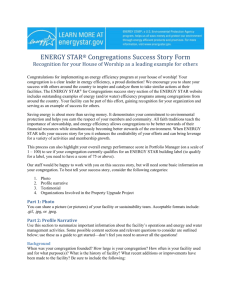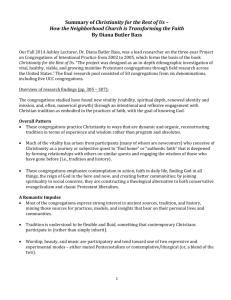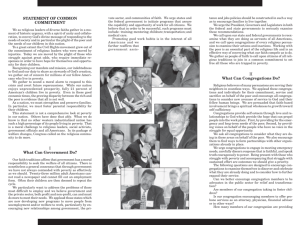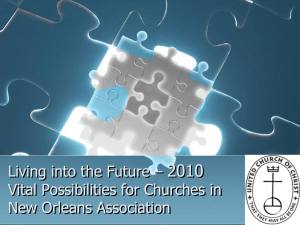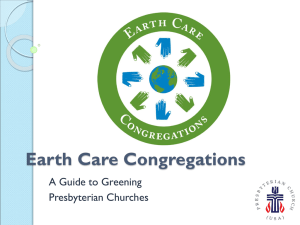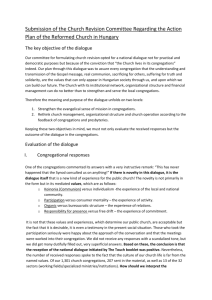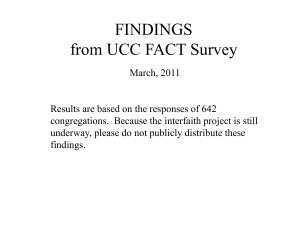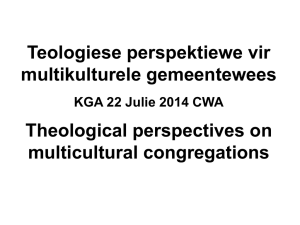HealthyLeaders201009 - Ohio
advertisement
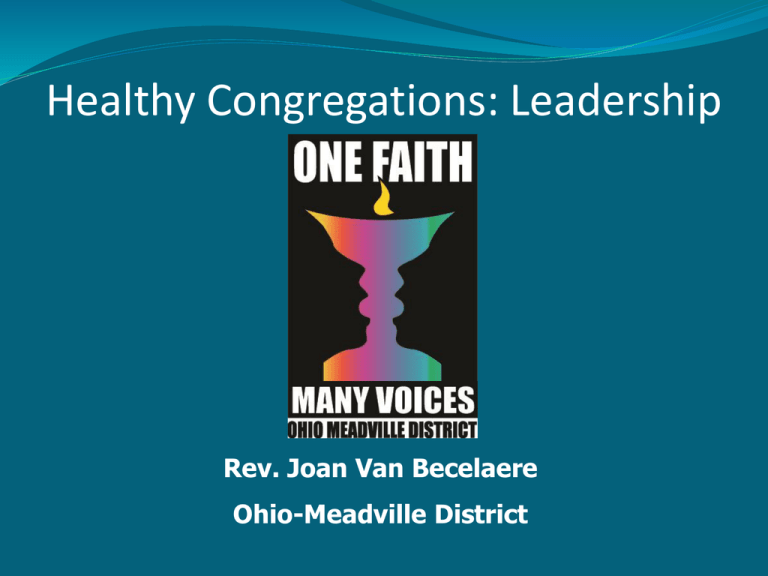
Healthy Congregations: Leadership Rev. Joan Van Becelaere Ohio-Meadville District Overview Part of a larger series of workshops on building Healthy Congregations. Full series is available Intro to Systems Thinking Some Myths and Theories Healthy Leadership Case Study Healthy Leadership In healthy congregations -leaders promote health through their presence and functioning (instead of techniques or skills.) -leaders challenge people (instead of comforting.) -leaders provide immune capacities (instead of enabling disease processes.) -leaders empower others (rather than dominate or cure them) “Relationships are all there is. Everything in the universe only exists because it is in relationship to everything else. Nothing exists in isolation. We have to stop pretending we are individuals who can go it alone.” Margaret Wheatley Basic Elements System Thinking = the 7th Principle in action Things do not exist independently, only in relationship Change in one part produces change in other parts Everything is co-causal - every cause is a reaction and every reaction is a cause. Basic Elements Systems thinking removes polarities of either/or, cause/effect thinking. No single cause to current state of being. Interactions between people affect the whole for good or bad Relationships are not merely interesting-that’s all there is!!! Basic Elements Where two or more are gathered, there is an emotional system. All human beings live in emotional systems. The same emotional processes occur in all relationships (family systems, etc.). Driving these systems are innate forces that seek survival. The resulting behaviors are not learned or thought out. They are “wired in,” automatic, instinctive, reactive, natural phenomena. Basic Elements Emotional systems driven by two innate forces: -the need to be separate/stand alone/independent -the need to be close/connect/interact with others. Balanced Separateness & Closeness forces = SelfDifferentiation Ability to define self to others and stay connected to them. Taking responsibility for own emotional functioning. Healthy leaders/persons/groups are: -separate and responsible for their lives -connected and responsive to others. Self-Differentiation Self-definition • 1 . Sensing limits, knowing where self and others begin and end, making the distinction between self and nonself yet being aware of the part self plays in relationship. • 2. Knowing what you believe, being aware of your goals and values, letting your own convictions determine your behavior. Self-Differentiation Self-regulation • 3. Taking a stand, articulating your position (and in doing this not having to change the other or change oneself to please the other), seeking clarity. • 4. Staying on course, having resolve, possessing emotional stamina, persevering, accepting challenge. Self-Differentiation Self-other relations • 5. Non-anxious, controlling the part one plays in emotional processes, being calm and reflective, focusing on one’s own functioning rather than the functioning of others, no blaming or attacking. • 6. Staying connected to others (we have to choose to do this, not instinctive). • 7. Going beyond self-promotion, being aware of the “other,” being as invested in the welfare of the relationship as in self. Basic Elements – Law of Fried Potatoes Self-Differentiation is evident in conflict. It is the capacity to “like the way your mother fried potatoes but not to be overwhelmed by anxiety if someone else’s mother fried them differently. This means you don’t try to convert others to your mother’s fried potatoes, nor do you give in to another’s need for fried potatoes of a certain kind. And you do not disconnect from another until they fry their potatoes your mother’s way.” (Steinke) Basic Elements Congregations are emotional systems with habits that resist change ---even when dysfunctional. Current issues may have more to do with past emotional processes (baggage) than with the logic of the current situation We’ve always done it this way – even though we hate it! No emotional system will change unless people change how they behave and function with one another in the system. Myths of Leadership How did we learn about this myth? How has our belief in this myth kept us from recognizing and taking ownership of our own leadership abilities? [T]here is an unconscious conspiracy in our country to discourage and suppress genuine leadership. A widespread unspoken fear of the potentially negative consequences of creative leadership blankets our thoughts and actions. It prevents the most talented among us from talking boldly or expressing ourselves as leaders. This conspiracy is all-encompassing, lulling us into conformity, complacency, cynicism and inaction. As a nation, as organizations and as individuals, we fear taking risks. We do not expect ourselves or others to stand up and be counted, and become frightened when they do.” Warren Bennis, Learning to Lead Myths of Leadership- Bennis Leadership is a rare skill. Leaders are born, not made. Leaders are charismatic. Leaders exist only at the top of an organization. Leaders control, direct, prod, manipulate others. Leadership (doing the right things) vs Management (doing things right) Super-heroes – No one can do it like I can. If I don’t do it, no one will Morphic Leadership - Martoia Morphing: “Morphic leadership means profound interior transformation, and it forms the basis for seeing culture change with lasting results.” Leaking: Our attitude, disposition, world view, mental model, approach toward people confirmed in the stories we tell in word and deed. Ethos: Corporate culture of the congregation, world view, sum total of all of the mental models, paradigms. Leadership Leaking - Martoia 4 LAWS OF LEAKING (Ethos Creation) All of us leak. (all have effects, all can be leaders) Leaking has pervasive effects, and bad leaking works faster than good Leaking is usually unconscious and unintentional. Leaking can’t be faked or fabricated in the long term. Shifts in Leadership Concepts OLD CONCEPT: leadership is about finding the answers we need. SHIFT: leadership is more about the right questions being asked in the right context in the right time. Shifts in Leadership Concepts OLD CONCEPT: Leadership is about skill set acquisition. SHIFT: leadership is more about fully being, inhabiting my destiny, and having an inner morphic (transformational) spiritual life. Shifts in Leadership Concepts OLD CONCEPT: leadership is about arriving at a goal, taking a summit or storming a hill. SHIFT: leadership is more about crafting the present ethos, which is the organic soil that nurtures the future ministry of all members of the congregation. Shifts in Leadership Concepts OLD CONCEPT: leadership is about serial sequencing, getting qualified first. SHIFT: leadership is about parallel simultaneity, learning while doing and taking important risks. Shift in Leadership Concepts Ronald Heifetz Leadership Without Easy Answers “Leaders do not need to know all the answers. They do need to ask the right questions.” Telling Our Stories Small Groups Tell a story about when you felt most like a leader.. What was the outcome and how did you feel? How were other people impacted by the event and your actions? Did it change anything in your life? Discuss the elements of leadership seen in the story. Healthy Leadership Leadership is the spiritual process of discerning what one believes (clarity), acting on that belief in the public arena (decisiveness), and standing behind that action despite the varied responses of people (courage). Rev. Frank Thomas Healthy Leadership Leaders and followers are a system. Leadership is co-created. The leader is the person who most influences an emotional field or system. Leaders learn to manage themselves first. The differentiated, non-anxious leader thinks from an “I position” and focuses on their own functioning while still staying connected to others. Healthy Leadership His/her influence does not rely on personality, consensus, techniques or skills, piles of information, or expertise. Responsible for their own functioning & not how others function. (no superheroes!) The system is influenced most – positively or negatively - by the leader’s BEING (non-anxious, self-aware presence) and DOING (selfdifferentiated, balanced functioning). Video Case Study Discussion – Large Group After viewing the video – Do you think that the more leaders accept responsibility for anxiety that is not theirs, the more they become stressed, function less effectively, and lose sight of their goals? Discussion-Small Group Leaders need to be able to tolerate “pain” both in themselves and others. They often need to make decisions that can bring change and, thus, pain to others. How well do you tolerate pain/uncomfortable feelings? What impact does this have on your leadership? What groups or persons in your congregation are unable to tolerate pain and change? Leaders as Health Promoters “Leaders contribute to the health of a congregation. They are healthpromoters. The true mark of a leader is spreading health throughout the community. The presence of mature, self-aware, and faithful leaders means health is possible in the community.” (Peter Steinke) Leaders Provide Immunity Leaders Provide Immunity Everything is co-causal, mutually influenced. Both health and illness are the result of interrelated factors. Viruses are always present. Disease only happens when surrounding cells cooperate. There are similarities between viral infections and relationship conflict. Leaders Provide Immunity Anxious, reactive people function like a virus. They are secretive. They selectively invade. They get other cells to go along - to avoid upsetting the system. Viral infections and anxiety/conflict – both are contagious and enabled & nurtured by the larger system. Leaders Provide Immunity Healthy leaders function as the community’s immune system when anxiety/conflict might damage the community. Leaders recognize what does and does not belong to the group and if behaviors are damaging to the welfare of the whole. Leaders respond thoughtfully and carefully, and then remember how to respond to similar threats in the future. Discussion What signs do you see that a person may be acting like a virus? Are there instances in your congregation where someone or a small group has acted like a virus? How did the congregation respond? How do congregations enable anxious reactivity to viruses? What can you and other leaders do to provide a strong immune system? Leadership and Mission Humans have a pervasive need for connections and relationship. A congregation is an expression of that need for connectedness and purpose. We need to explore and know why we have come together (Mission!) Leaders help the congregation develop a vision of how it will live out its mission and purpose. Leadership and Mission • Healthy congregations have ‘coherence’ in midst of change/conflict, provided by leadership. • Aaron Antonovsky : coherence results from: ◦ Meaningfulness-overall sense of purpose that enables folk to make commitments, get involved, and shape destiny (Mission!) ◦ Comprehensibility-making cognitive sense of what is happening, objectivity, clarity that allows for hope ◦ Manageability-confidence in ability to deal with life, belief in ability to control and influence events (no victims allowed) Leadership and Mission When a congregation focuses on mission and strength, it will look to the future and increase its ability to handle conflict, change or renewal. A group focused on weakness and what is wrong will fall into hopelessness, pathology, blame and deficits. A group focused on its purpose and strengths will build on them & move forward through change or anxiety. Healthy Congregations Workshops Facilitator training – March 4-6 at West Shore Creating Healthy Congregations Healthy Congregations Respond to Anxiety and Change. Leadership in Healthy Congregations Relationships in Healthy Congregations Healthy Congregations Nurture Generous People Healthy Spirituality Bibliography Congregational Leadership in Anxious Times , by Peter Steinke, Alban Institute Leading Change in the Congregation: Spiritual and Organizational Tools for Leaders, by Gilbert R. Rendle. Alban Institute. Healthy Congregations: A Systems Approach, by Peter Steinke, Alban Institute. Margaret Wheatley: People are the solution to the problems that confront us. Technology is not the solution, although it can help. We are the solution – we as generous, open-hearted people who want to use our creativity and caring on behalf of other human beings and all life. Thank you for being here today! Unitarian Universalism is a Covenantal Faith We are a covenantal faith, not a creedal faith. We share a covenant of how we try to be together, not a creed of what we all must believe together. Rev. Thom Belote (adapted) A Covenant … Is a statement of agreement about how congregants choose to be in relationship with each other. Comprises promises, not rules. Is a framework of expectations. Is about behavior, not personality. Offers an opportunity to explore and deepen our spirituality. Core-Practices of Life Affirming Leaders - Wheatley Know they cannot lead alone. Have more faith in people than they do in themselves. Recognize human diversity as a gift, and the human spirit as a blessing. Act on the fact that people only support what they create. Core-Practices of Life Affirming Leaders - Wheatley Solve unsolvable problems by bringing new voices into the room. Use learning as the fundamental process for resiliency, change and growth. Offer purposeful work as the necessary condition for people to engage fully. Healthy Communication Truth-telling Willingness to discuss difficult issues Staying connected through conflict Understanding boundaries Respecting Confidentiality Problematic Communication Quandaries Rumors – misinformation Gossip – may be accurate but spread outside of established communication channels Exposure – revealing too much information that would be considered socially appropriate Leaking – information is released intentionally, without regard to covenants or established boundaries Level of Information Disclosure Private – known only by person who owns it Confidential – released to a second person with assurance that it won’t be shared without expressed permission Limited access – known by 3 or more but protected from distribution by agreement Open – share openly with the congregation but not easily accessible to public Public – information that is easily accessible The Elephant in the Room What issue is difficult to talk about in your congregation? Do you believe that people’s functioning will improve if they know the truth? Telling the Truth Half-truths or shaded truths can be as destructive to community life as no truth. Secrets (deceit, the unspeakable, denial, lies, clandestine gatherings, shrouded truth, underhanded behavior, cover up, covert activities) increase when conflict thickens and expands. Forgiveness Forgiveness does not change the past, but it does enlarge the future.” ~Paul Boese Without forgiveness, there is no future. ~Desmond Tutu
